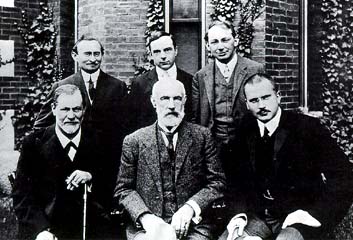| Return to Lecture |
In the psychological literature, the work of Carl Gustav Jung and his students has been the most focused on the role of religious or spiritual symbolism in personal development and in psychotherapy. It serves as the basis for our discussions of what constitutes"psychological art." This is a good point to review Jung and tie him directly to the Perennial Philosophy.
| Jung expanded on the work of his teacher, Sigmund Freud, who had asserted that symbolism, whether personal dream symbolism or cultural symbolism (such as we find in myth or art) was, in its origin, an expression of personal conflicts between conscious and unconscious impulses. Jung took the idea several steps farther, and postulated that there were universal symbolic patterns which emerged in the life of individuals. These patterns, which he called "archetypes" could carry personal meaning, but in another sense, also carried universal meanings, because they originated in the collective experience and constraints of all humans. For example, were one to dream of oneself in a sarcophagus, this might indicate a personal concern about death, but on the other hand, death is a universal experience, and can stand as a metaphor for any significant change or transformation. Marriage is such a change; it is the death of a certain form of autonomy. | xxxx |  |
| xx | Group photo in front of Clark University Sigmund Freud, Stanley Hall, C.G.Jung; Back row: Abraham A. Brill, Ernest Jones, Sandor Ferenczi. Photo taken for Clark University in Worcester, Massachusetts publication. |
Jung also postulated that when these collective, archetypal patterns expressed themselves in one's personal life, they were a sort of expression of a developmental wisdom -- that they indicated directions one could grow. The ultimate direction of growth is to wholeness, a wholeness which integrates the concerns of the world and the spirit (in Jung's language). In this sense we could say that when these symbols express themselves in the work of many artists, they may indicate a suggested resolution of personal problems, but in the art of a more developed artist, they may express a resolution to the ultimate human problem, which is achieving a wholeness which integrates the concerns of this world (the secular) with the concerns of the spirit (the sacred). Jung termed this developmental progress to human completeness the achievement of gaining the Self, as opposed to the child's development of an ego.
In the context of the Perennial Philosophy, we may say that when one has successfully worked their way through individual psychological conflicts, then they have achieved the wholeness of the Self. And being whole, they have made transparent those personal coverings over the fundamental Divine Ground of one's being. As we will read shortly, Huxley asserts that there are four fundamental doctrines in the Perennial Philosophy. The second is that "man possesses a double nature, a phenomenal ego and an eternal Self, which is the inner man, the spirit, the spark of divinity within the soul. It is possible for a man, if he so desires, to identify himself with the spirit and therefore with the Divine Ground, which is of the same or like nature with the spirit." Hence, we may hypothesize that certain artists have achieved this wholeness, and through this have transformed their personal, psychological art, into something more universal, perhaps something in the nature of sacred art.
This entire Jungian perspective was explored in some detail in the course reading, Man and His Symbols, so I will not review this theme in detail here. But it is important to point out that most religious traditions draw a distinction between art created with a personal vision, and art created through the use of universal models (this is what we call "iconic" art). The former (personal) is considered what we might call a product of the ego, while the later (universal) is a product of the Divine Ground or the Self. Exploration of this distinction has been a critical issue in this course.